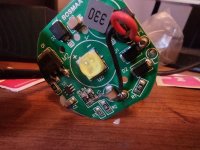pwd
10 kW
I have these LED drivers which both failed after less than 5 hours each. My estimate is that they failed because they are rated for an input voltage of 10-80VDC but my pack is 86.1V full. I didn't notice when the first one failed but the second one failed when I turned it on via a simple on-off switch.
Can these boards be repaired and improved to handle the 86V input without popping?
Can these boards be repaired and improved to handle the 86V input without popping?



